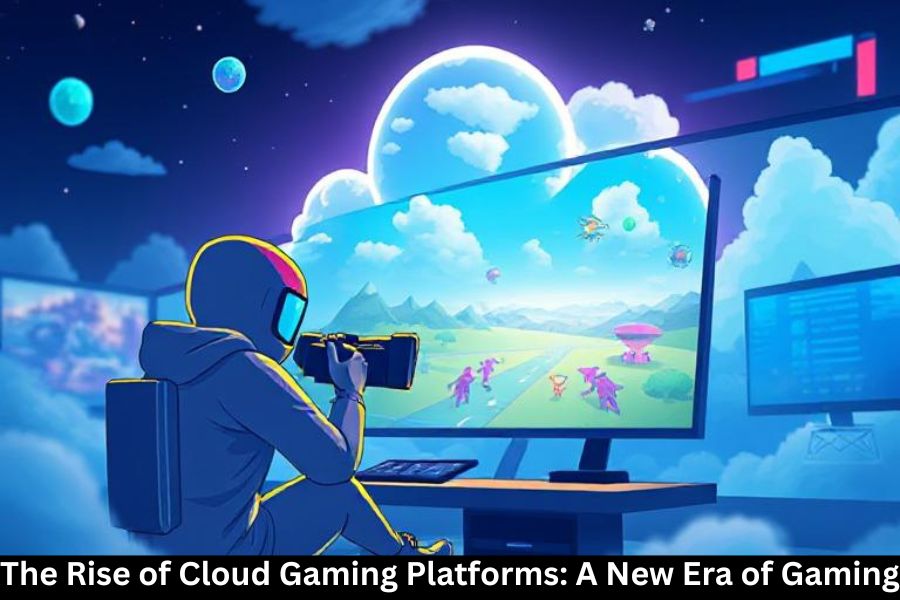Cloud gaming, also known as game streaming, is a revolutionary concept where video games are hosted on remote servers and streamed directly to a user’s device, without the need for dedicated gaming hardware. Instead of running games locally on a console or PC, the game is processed in real time on the cloud (i.e., a remote data center) and sent to your device via the internet.
How Cloud Gaming Works
In cloud gaming, when a user launches a game, the input commands (like joystick movements or button presses) are sent to a remote server. The server processes the game, renders the graphics, and sends the video feed back to the user’s device. This process happens almost instantaneously, with minimal delay, provided that the user has a fast and stable internet connection.
The Evolution of Cloud Gaming
Early Beginnings: Streaming Games vs. Cloud Gaming
Cloud gaming isn’t a brand-new idea. In the early 2000s, services like OnLive (launched in 2010) and Gaikai (launched in 2008) offered game streaming in some form. However, these services were limited by the technology of the time, including slow internet speeds and poor server infrastructure.
The Growth of Cloud Gaming Technology
Over the past decade, cloud gaming has seen massive improvements. With faster internet speeds, especially the rollout of 4G and 5G networks, cloud gaming has become more feasible. Big tech companies, such as Google, Microsoft, and Sony, began heavily investing in cloud gaming technology, making it more accessible to the mainstream gamer.
Popular Cloud Gaming Platforms
Google Stadia: The Pioneer
Google Stadia, launched in 2019, was one of the first major cloud gaming services to attract widespread attention. It promised high-quality gaming with no need for dedicated hardware. While the service has faced criticism over game selection and other factors, it demonstrated the potential of cloud gaming platforms.
Microsoft Xbox Cloud Gaming (formerly xCloud)
Microsoft’s Xbox Cloud Gaming, which is part of the Xbox Game Pass Ultimate, allows users to stream a wide range of Xbox games to their devices. The service benefits from Microsoft’s extensive cloud infrastructure, which enables seamless integration with existing Xbox consoles and a large game library.
NVIDIA GeForce NOW
NVIDIA’s GeForce NOW lets users stream games they already own on platforms like Steam, Epic Games Store, and Uplay. With its emphasis on high-performance gaming and cloud-powered graphics, GeForce NOW is often praised for its low-latency experience.
Sony PlayStation Now
Sony’s PlayStation Now allows gamers to stream a selection of PlayStation 2, 3, and 4 games to PlayStation consoles and PCs. While PlayStation Now is not as high-profile as some other services, it has a loyal user base and is an important player in the cloud gaming space.
How Cloud Gaming is Changing the Gaming Landscape
Accessibility: Gaming Anywhere, Anytime
Cloud gaming eliminates the need for physical consoles or gaming PCs. Whether you’re using a laptop, smartphone, or even a smart TV, you can play high-quality games without worrying about hardware limitations. It opens up the world of gaming to people who might not have access to high-end gaming systems.
No Need for Expensive Hardware
Traditionally, playing graphically intense games required a powerful gaming PC or console. With cloud gaming, all you need is a stable internet connection, making gaming more affordable and accessible. This democratizes gaming and lowers the entry barrier for many people.
The Impact on Game Distribution
Cloud gaming also changes the way games are distributed. Instead of buying physical copies or downloading massive files, players can simply stream games. This has sparked a shift from traditional retail models to subscription-based streaming platforms.
The Shift in Game Development
With cloud gaming becoming more widespread, game developers are focusing on optimizing their titles for streaming platforms. This shift encourages developers to think about performance optimization, cross-platform compatibility, and the scalability of their games.
Key Benefits of Cloud Gaming
Instant Access to Games
Gone are the days of waiting for long downloads or installations. Cloud gaming offers near-instant access to games, which means you can jump straight into the action without delay.
Cross-Platform Play
Cloud gaming makes cross-platform play easier than ever. Since games are streamed from remote servers, it’s possible for players on different devices (PC, console, mobile) to play together seamlessly.
Reducing the Need for Downloads and Updates
With cloud gaming, players don’t need to download large game files or wait for updates. The games are streamed directly, reducing storage needs and eliminating the constant need for patch downloads.
Cost-Effectiveness
Cloud gaming platforms often operate on a subscription model, allowing gamers to access a library of games for a fixed monthly fee. This offers a more affordable alternative to buying individual games, especially for casual gamers who play a variety of titles.
Challenges of Cloud Gaming
Internet Speed and Latency Issues
While cloud gaming has improved dramatically, it still relies heavily on a fast and stable internet connection. High latency and lag can ruin the gaming experience, making it less suitable for fast-paced or competitive games.
Limited Game Library
Although cloud gaming platforms offer a wide selection of games, the libraries are still smaller compared to traditional consoles or PCs. Some game developers are also hesitant to bring their titles to cloud gaming services due to the potential loss of control over distribution and piracy concerns.
Data Privacy and Security Concerns
Cloud gaming raises concerns about data security, as sensitive information like payment details and personal gaming habits are stored on remote servers. Protecting this data from hackers and unauthorized access is a significant challenge for cloud gaming platforms.
Lack of Ownership: Are You Really Buying Games?
One of the criticisms of cloud gaming is that you don’t actually “own” the games you play. If a platform shuts down or removes a game from its library, you lose access to it — even though you’ve paid for it.
The Future of Cloud Gaming
The Role of 5G in Cloud Gaming
With the rollout of 5G networks, cloud gaming is expected to become even more seamless. Faster internet speeds and lower latency will enhance the gaming experience, making it more suitable for high-performance, real-time gaming.
Upcoming Technologies and Innovations
Innovations such as AI-powered game optimization, edge computing, and improved cloud infrastructure will continue to push the limits of cloud gaming. Expect significant advancements in graphics, responsiveness, and overall game quality.
The Potential for VR/AR Integration
As virtual reality (VR) and augmented reality (AR) become more mainstream, cloud gaming could provide the necessary power to run these demanding experiences on devices that would otherwise struggle with them.
Cloud Gaming’s Impact on Esports
Esports is another area where cloud gaming could have a significant impact. Competitive gamers could access high-performance cloud servers to compete in tournaments, without the need for expensive hardware setups.
Cloud Gaming vs Traditional Gaming: A Comparison
Performance and Graphics
While traditional gaming typically offers superior graphics and performance, cloud gaming technology is rapidly catching up. The gap will continue to shrink as cloud servers become more powerful and internet speeds improve.
Ownership of Games
In traditional gaming, purchasing a physical or digital copy means you own the game. In cloud gaming, however, you’re essentially renting access to the game, and you risk losing it if the platform changes its offerings.
Cost Comparison
Cloud gaming can be more affordable for casual gamers who don’t want to invest in expensive hardware. However, for serious gamers, investing in a high-performance PC or console might still offer better value in the long run.
Social and Multiplayer Experience
Traditional gaming consoles have a strong emphasis on local multiplayer and social experiences. Cloud gaming, on the other hand, is centered around online play, offering more flexibility in connecting with players from around the world.
How Cloud Gaming is Shaping the Industry
The Decline of Physical Copies
As cloud gaming rises, we are witnessing the decline of physical game copies. Retail stores have already started scaling back, and more players are opting for digital downloads and streaming services.
Subscription-Based Models vs. One-Time Purchases
Subscription-based models are gaining popularity, offering players access to a wide range of games for a monthly fee. This is challenging the traditional one-time purchase model, making games more accessible and affordable.
The Future of Game Consoles
With the rise of cloud gaming, traditional gaming consoles may become less important. While consoles will still have a place in gaming culture, they may eventually evolve into cloud-based systems, where all the processing is done remotely.
Conclusion: Is Cloud Gaming the Future of Gaming?
Cloud gaming is undeniably shaping the future of the gaming industry. It offers unparalleled accessibility, affordability, and convenience. However, it’s not without challenges, especially regarding internet speeds, latency, and game libraries. As technology advances, cloud gaming is likely to become even more widespread, making it a viable alternative to traditional gaming. Whether or not it will fully replace traditional gaming remains to be seen, but it is certainly here to stay.
FAQs
1. Is cloud gaming better than traditional gaming?
It depends on what you prioritize. Cloud gaming offers convenience and affordability, but traditional gaming offers better performance and ownership.
2. Can cloud gaming replace consoles and PCs?
In time, it might, especially with the advancement of 5G networks and cloud infrastructure. However, for now, traditional gaming platforms still provide superior performance.
3. What do I need to play games via cloud gaming?
All you need is a device capable of streaming (like a smartphone, tablet, PC, or smart TV) and a stable internet connection.
4. Will cloud gaming reduce gaming costs?
Yes, subscription models can be more affordable than buying individual games or investing in expensive gaming hardware.
5. What is the most popular cloud gaming platform?
Microsoft’s Xbox Cloud Gaming (formerly xCloud) and NVIDIA GeForce NOW are two of the most popular cloud gaming services today.



